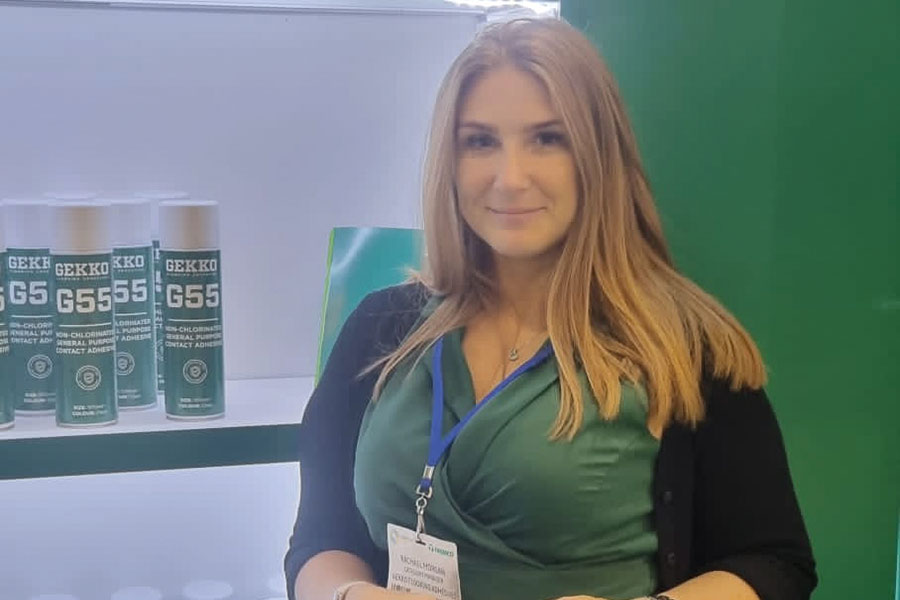Compatibility and suitability are things you look for when selecting a flooring adhesive,
and a flooring spray adhesive should be no different, says Rachael Morgan.
‘I’LL just use a carpet spray on this vinyl’; ‘Contact spray will be much quicker on this PVC’; ‘I’ll just spray it down.’ Does any of that sound a little too familiar?
I can’t be the only one wondering when spray adhesives became this go-to cheat sheet in floor-fitting. And although I do agree that spray adhesives have come a long way in the past 15 years, unfortunately they’re not a magic fix-all, and like their bucket counterparts still need to be fit for their intended purpose.
Compatibility and suitability are things you look for when selecting a flooring adhesive, and a flooring spray adhesive should be no different.
A super-simple, and relatable example or a common mistake I imagine a great deal of you have made at some point in your career, is using a carpet or contact spray with a domestic vinyl. Now some felt or cushioned back domestic vinyls may be OK if they’ve been tested by the adhesive manufacturer, or resist the effects longer. However if there’s little or no backing to create a barrier between the vinyl and the adhesive then plasticiser migration will likely occur.
But it’s important to know that this isn’t an instant reaction; it can take months, sometimes years to present in the form of surface affects and this time is dependent on many things in the environment such as temperature, light levels and foot traffic, to name a few.
Most commonly plasticiser migration presents as surface discolouration, sagging or bubbling of the vinyl.
So, here’s a quick lesson or refresher in plasticiser migration for those who aren’t sure what I’m talking about. Let’s start with a definition of plasticisers. They’re compounds added to vinyls and PVC profiles to make the product more flexible.
Second, why does it present a problem for flooring contractors? Plasticisers react with other materials including rubber, latex and some solvents, causing them to migrate out of the PVC and into the glue line.
The vinyl or PVC then becomes more brittle and the adhesive turns soft causing bond failure.
Finally, how do you spot plasticiser migration? Classic signs include staining or discolouration of the floors surface, bubbling and sagging of the vinyl, cracking, peeling and (often with PVC skirtings and capping) complete failure as the products come away from the walls.
Circling back to my earlier statement that spray adhesives have come a long way in the past 15 years, this can be seen in the flooring market today with the variety of formulation types from traditional SBRs in many different solvent carriers, polyurethanes to new water-based technology.
With an ever-growing breadth of adhesive types available from carpet, contacts, vinyl, PVC, surface tackifiers to pressure sensitive the list is expanding as new innovations challenge the norm.
The sprayable portfolio is changing with the times and so too must the market. Spray adhesives don’t have to be a dirty little secret when used correctly. Be safe, not sorry. Ask the manufacturer to test compatibility of substrates, lean on them for advice and support, use their technical teams and experts, and most importantly expect the same high standards from your spray brand as you’d expect from your bucket, bag or bottle.
The last thing the market needs is just another flooring spray!
Performance is paramount in any professional installation, just as is the safety of you and your team, so familiarise yourself with the substrates and subfloors an adhesive is suitable for. TDSs can be a good read and an eye opener.
Familiarise yourself with the safety data, control measures recommended by the HSE just as you would with your go-to bucket adhesive. Educate yourself and your team on the proper uses and limitations of these 500ml wonders.
We all know education is needed in the trade around the whole subject of sprayable adhesives from performance to safety – and we also know that change is coming.
So for today I leave you with this message: a simple change could make a lasting impression, take care of your future self and remember it’s never too late to make the switch to DCM-free or invest in suitable PPE.
WARNING: don’t be afraid to seek medical attention immediately if you’re concerned by side effects or symptoms you may be experiencing; there’s no shame in prioritising your health and wellbeing.
The most common side effects of DCM are relatively well-known such as dizziness, coughing and wheezing, but there are also side-effects of using a DCM-based adhesive that are often overlooked or not credited to spray use, such as skin rashes, headaches and blurred vision. Other symptoms can develop over time and prolonged use can lead to kidney problems and even cancer.
www.quinglobal.com
Rachael Morgan is category manager, Quin Global


